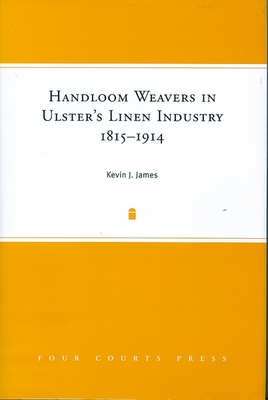Handloom Weavers in Ulster’s Linen Industry
Dorothy Calvert reviews Handloom Weavers in Ulster's Linen Industry, 1815-1914, by Kevin J. James, Four Courts Press, ISBN 1-84682-001-4, £35 hbk

KEVIN JAME'S book is without doubt an intensively researched, scholarly work, the slimness of the volume belying the obvious breadth of information he clearly encountered during his research. It is extensively referenced and provides an enormous wealth of relevant reports, studies and works.
In his fact finding, he leaves few stones unturned on the journey from post-famine production through the post-1870 labour organisation and agitation in the face of industrialisation and increased emigration, through to the pre-first world war arts and crafts movement spearheaded by Morris and Ruskin.
He provides further evidence (though no acknowledgement) of the misogyny that supported the then culture of male proprietorship of the skill of weaving. He explains how men regarded their higher skill status as a "…natural extension of their social authority" (p.16) He incorporates further evidence of how mechanisation shaped society and bolstered capitalist values by encouraging competition - thus enhancing the power of the manufactory owner - that led, ultimately, to the decay of many skilled occupations.
Data collection is a valid part of recording history. A look at the volume of references to works already providing some of this information makes me wonder what the point is of continuing to provide the same scientific information (a current conservative trend and one which excludes humanity).
James does say that analyses of linen handloom labour are limited, compared to counterparts in other factory work fields. His study could have drawn attention to the fact that the recorders of the statistics were men, who were also predominantly the men who record the history.
My discomfort with this book is that he misses an opportunity to humanise working-class history, leaving us with an unbalanced perspective of the life of those times. The book would have come to life, had he at some point made comparisons to, or acknowledged, the belittling of women's work in many other areas of working life (musicians, writers, medicine) and explored more the cultural (ergo men's) ideology of gender.
I wonder is it academic laziness to continue to be confused in the uses of sex and gender?
James' language is inaccessible throughout. I say this not because people other than academics (in itself a traditionally male dominated culture) are any less capable of intellectual thought and concepts, rather because I believe that political writing should be written with a desire and ability to reach as many people as possible with its clarity.
Who is history written for? Other historians? Could it not be that we all want to know our history in order to use it to make sense of the world we now live in and how we got to this point in time? For that, this book would have to be less like a Ph.D.
I would have to say that you can get your statistics here, but make sure you read the E P Thompsons and the Betty Messengers of the world to understand what effect all these figures had and have on people's lives and indeed how to make sense of it in today's global marketisation context.
Connolly Association, c/o RMT, Unity House, 39 Chalton Street, London, NW1 1JD
Copyright © 2007 Dorothy Calvert

